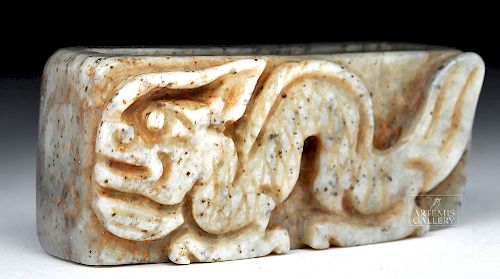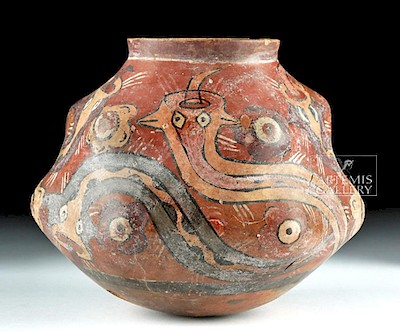Chinese Jade Scabbard Slide w/ Dragon - Ming or Earlier
Lot 107
About Seller
Artemis Fine Arts
686 S Taylor Ave, Ste 106
Louisville, CO 80027
United States
Selling antiquities, ancient and ethnographic art online since 1993, Artemis Gallery specializes in Classical Antiquities (Egyptian, Greek, Roman, Near Eastern), Asian, Pre-Columbian, African / Tribal / Oceanographic art. Our extensive inventory includes pottery, stone, metal, wood, glass and textil...Read more
Estimate:
$700 - $1,050
Absentee vs Live bid
Two ways to bid:
- Leave a max absentee bid and the platform will bid on your behalf up to your maximum bid during the live auction.
- Bid live during the auction and your bids will be submitted real-time to the auctioneer.
Bid Increments
| Price | Bid Increment |
|---|---|
| $0 | $25 |
| $300 | $50 |
| $1,000 | $100 |
| $2,000 | $250 |
| $5,000 | $500 |
| $10,000 | $1,000 |
| $20,000 | $2,500 |
| $50,000 | $5,000 |
| $100,000 | $10,000 |
| $200,000 | $20,000 |
About Auction
By Artemis Fine Arts
Jul 5, 2018
Set Reminder
2018-07-05 10:00:00
2018-07-05 10:00:00
America/New_York
Bidsquare
Bidsquare : Ancient | Ethnographic | Fine Art
https://www.bidsquare.com/auctions/artemis-gallery/ancient-ethnographic-fine-art-3306
Featuring classical antiquities, ancient and ethnographic art from cultures encompassing the globe. Artemis Fine Arts info@artemisfinearts.com
Featuring classical antiquities, ancient and ethnographic art from cultures encompassing the globe. Artemis Fine Arts info@artemisfinearts.com
- Lot Description
East Asia, China, probably Ming Dynasty, ca. 1368 to 1644 CE. A carved stone scabbard slide with a bas relief dragon. The dragon is shown from the side, in a dynamic, leaping pose. The stone is a grey-green with small brown-black inclusions. This is the simpler form of the scabbard slide, consisting of just an enclosed aperture; Trousdale (1975) classifies this shape as Form II, Profile Type A(2). Although stone scabbard slides stopped being utilitarian objects around the first century CE, they continued to be produced for centuries afterwards. Size: 1.8" W x 0.8" H (4.6 cm x 2 cm)
The scabbard slide was invented in the steppes of the southern Ural Mountains 2500 years ago, developed to manage the long iron equestrian sword. In China, nearly all of these objects are made from "jade" in the widest sense; elsewhere, there are also examples in bronze, lacquered wood, gold, and ivory. The purpose of these objects was forgotten until the 20th century, when some were scientifically excavated from undisturbed archaeological contexts. Now we know that the scabbard slide was attached, using silk thread or a thin strip of metal, to a flat or ribbed part of the scabbard, facing away from the body and generally at the balance point. A belt, usually of leather, would go through the slide.
c.f. Trousdale, W. 1975. "The Long Sword and Scabbard Slide in Asia." Smithsonian Contributions to Anthropology, No. 17.
Provenance: private collection of Dr. Evan Maurer, a former Curator of the Minneapolis Art Institute (USA)
All items legal to buy/sell under U.S. Statute covering cultural patrimony Code 2600, CHAPTER 14, and are guaranteed to be as described or your money back.
A Certificate of Authenticity will accompany all winning bids.
We ship worldwide and handle all shipping in-house for your convenience.
#132101Intact, with some wear and patina on surface indicative of its age.Condition
- Shipping Info
-
All shipping is handled in-house for your convenience. Your invoice from Artemis Gallery will include shipping calculation instructions. If in doubt, please inquire BEFORE bidding for estimated shipping costs for individual items.
-
- Buyer's Premium



 EUR
EUR CAD
CAD AUD
AUD GBP
GBP MXN
MXN HKD
HKD CNY
CNY MYR
MYR SEK
SEK SGD
SGD CHF
CHF THB
THB


















